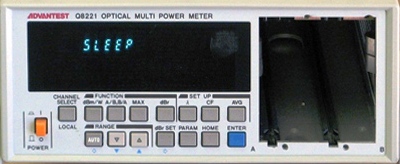
|
|
The Advantest Q8821 Optical Multi Power Meter employs a two-channel plug-in system. Various optical sensors and light sources are available as plug-in units. The two channels of the Q8221 can be used individually or simultaneously. Free combination of optical sensors and light sources enables diverse applications. The optical sensors for Q8221 assure high accuracy of ±2.5% at calibration point. In broad band wavelength region, they assure ±4.5% accuracy by compensating the sensitivity curve over wavelengths of each sensors. Further more, the linearity of ±0.5% is assured. Not only at the calibration point, these sensors also assure at the broad band wavelength region and the level to be measured. For all sensors, the Q8221 achieves a sampling speed of 100 times/sec. and a ranging speed (time required to move to a different range) of a maximum of 500 msec (minimum 20 msec). In addition, GPIB output can be transferred at a high speed of 100 times/sec., thus dramatically increasing the throughput of production lines. The Q8221 is capable of storing data containing 400 points with the A and B channels independently. Furthermore, stored data can be directly output to an external plotter as a graph. Also, PDL measurement is very easy with Q8221, because Q8221 can display maximum and minimum values as well as the difference between the maximum and minimum values of the measured data. Specifications. Sensor plug-in channels: 2 (Channels A and B). Resolution: dBm/dB display: 0.001 dB (or 0.0001 dB for data output via GPIB) W display: Max.199,999 counts. Measurement mode: CW or chopped light (270 Hz) measurement mode selectable. Averaging function: The number of averaging can be set to 2 to 256 using the running averaging method. GPIB interface: IEEE488-1978.
|